Welcome back to my 1,000-mile trip review in the 2017 Chevy Bolt EV. This is the third part of a three part series, so be sure to check out Part 1 and Part 2 if you want to catch up.
In this article, I'll provide a quick review of the weekend and describe the 500-mile trip home. I'll also provide a summary of the entire trip, compare and analyze data from the two 500-mile legs, and share a couple of rants along the way.
Trip Planning Isn't Just for EVs
Before I start, I also want to acknowledge a point that was made by several internal combustion vehicle drivers. Essentially, their claim is that they don't have to do any trip planning in their vehicles. While that might work for them, I've always planned my trips, regardless of what vehicle I'm driving. I want to know the road conditions and weather, and I want to have a basic itinerary for the trip. Checking these things doesn't take much time, and it's well worth doing, in my opinion.
And, of course, having an itinerary doesn't prevent spontaneity. You can always make unplanned stops, and at that point, the itinerary simply serves as a budget. It makes it easier to identify what you need to change or give up in order to enjoy that stop.
The only thing that I check for a trip in an EV that I don't check in a gas car is charger statuses. Yes, that's partly to ensure that the chargers I plan to use are in good order, but it's also because the infrastructure is growing so quickly that new charging sites are opening almost weekly. Now, onto the trip!
Busy Weekend
My weekend in Northern California was fairly typical. I had a number of chores to do, and several errands that included shopping and picking up large items. Good thing the Chevy Bolt EV fits right in at the Tractor Supply store. I almost had to put the seats down in order to fit all the cargo. Almost.
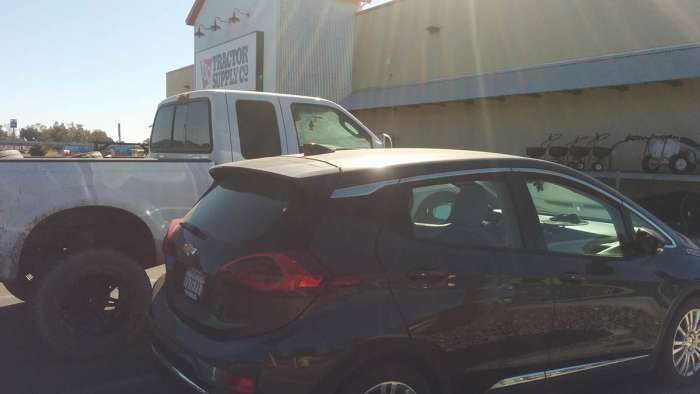
All told, I ended up driving 137.5 miles on Saturday, burning through 39.7 kWh of electrons with an efficiency of 3.46 mi/kWh. Other than wind, the weather wasn't particularly bad, and this has been my argument in favor of the Bolt EV for rural folk for a while. Without public charging infrastructure, the medium-range EVs with 100 to 150 miles of range just wouldn't be able to handle regular, almost daily driving routines. Luckily, though, that infrastructure is being built. While running my errands, I did check out some of the new public chargers that are being installed, and they are progressing quite well.
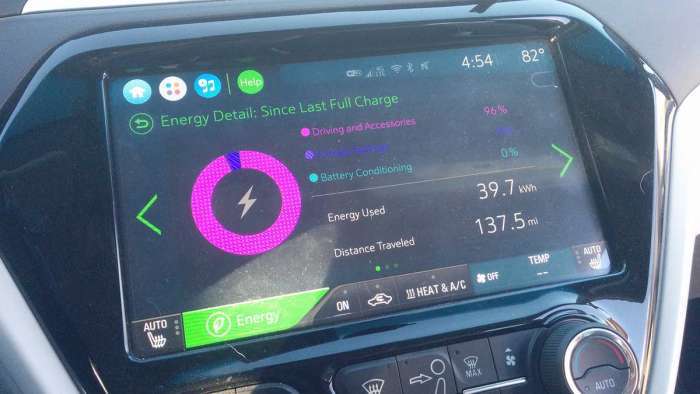 Trip Back to Southern California
Trip Back to Southern California
On Sunday, it was time to head back. The winds had died down, and the temperature was close to 90 degrees by the time I left at 2:30 pm. My initial plan was to return to Southern California using the same route I had used to drive north. I intended for my first stop to be the same Electrify America site in Turlock that I used on the trip north, which was about 180 miles out.
I ended up getting stuck behind a couple of slow-moving RVs and trailers heading down the mountain, but that's expected on a Sunday afternoon. It's a short run that only costs about 5 minutes. When I finally got onto the I-5 freeway, it was clear sailing, at least for a while anyway.
By the time I got to Sacramento about 90 miles out, the same road construction I encountered on the trip north was already causing problems. I was delayed nearly 15 minutes just getting through Sacramento and Stockton. According to Google Maps, I would have run into the same delays on Highway 99 as I was seeing on I-5.
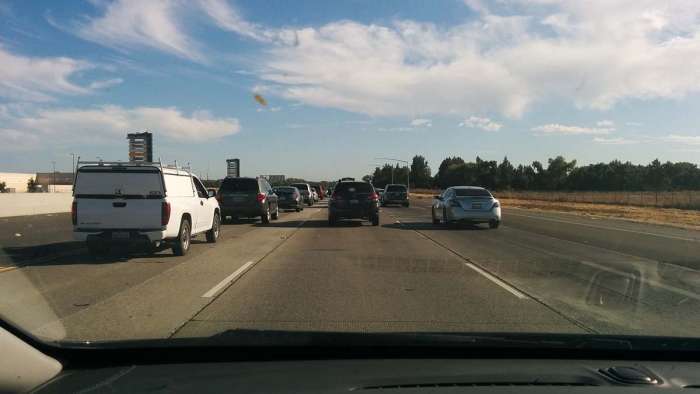
About halfway between Sacramento and Stockton, I decided that if I hadn't already crossed over to Highway 99, I might as well stay on I-5 the entire way. This would actually be the first time I made the trip south entirely on I-5 in my Bolt EV. The last time I had traveled this route, the ChargePoint site in Lebec still wasn't open, so I had to cross over to Highway 99 and charge up before heading over the Tehachapi Mountains.
This last-minute switch meant that my first stop would be the Electrify America site in Patterson. The Patterson site is not as ideally located as the Turlock site because it requires driving a little over a mile off the freeway, but it's better than the alternative of charging at the 50 kW ChargePoint site in Santa Nella (about 25 miles farther south on I-5).
First Charging Stop, Electrify America Patterson
I arrived in Patterson at 5:32 pm, more than 3 hours after I left. This was a bit disappointing because the drive should only take about 2 hours and 30 minutes, so instead of maintaining an average driving speed of close to 70 mph, I was averaging just under 60 mph. Also, because of the elevation decrease and slower driving speeds, I arrived with 15% battery after using only 48 kWh and was maintaining an efficiency of 3.78 mi/kWh.
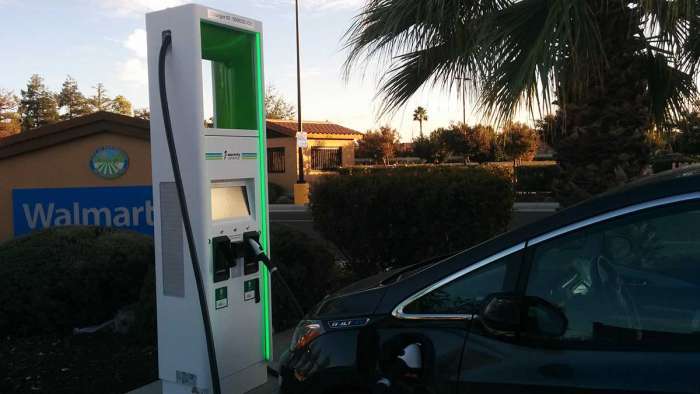
I knew I would be using ChargePoint chargers from here on, so I took the time to call ChargePoint's customer service to resolve a potential issue with my account (a charger had faulted and possibly locked my RFID card). I charged just long enough to make it to the next charger in Coalinga, so I ended my Electrify America charge session after 32 minutes. The charger delivered 27.8 kWh with a total cost of $5.93. By the time I left, my average trip speed was down to 49 mph.
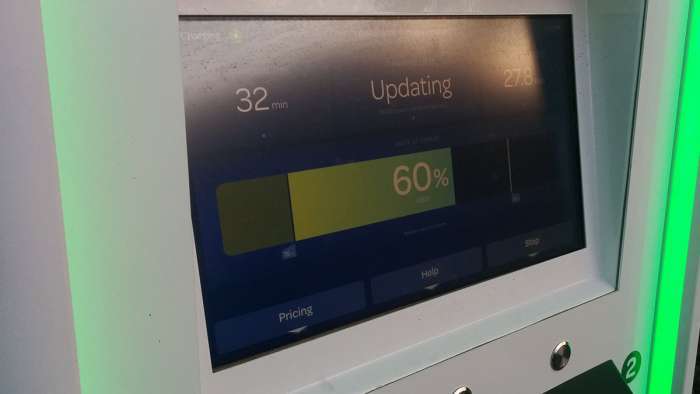 Second Charging Stop, ChargePoint Coalinga
Second Charging Stop, ChargePoint Coalinga
In hindsight, I should have charged for another 10 minutes in Patterson, but I had no way of knowing what came next.... Okay, enough of the cliffhanger. The drive from Patterson south was uneventful, and traffic was actually picking up pace. However, when I pulled in, all three chargers were in use by a Hyundai Kona Electric, Nissan LEAF, and another Chevy Bolt EV. This was my primary concern when planning the trip north. ChargePoint had finally "connected the dots" on I-5 between Los Angeles and Sacramento; however, three 50 kW chargers per site is nowhere near enough to meet current – let alone future – demand.
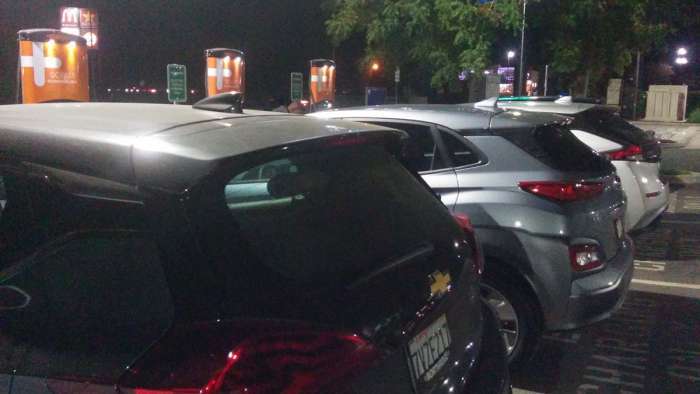
I had arrived in Coalinga at 7:32 pm, after 280.5 miles of total driving, so my average trip speed was back up to almost 56 mph. I had to wait about 10 minutes before the Kona Electric's charge session ended. Its owner, Josh, had set the charge limit in the Kona at 80%, so the charger immediately shut off when the battery hit that point. I pulled in with 7% battery, started my charge at 7:44 pm, and headed off to dinner. I knew this would probably be the longest charge session of the trip, so I had planned it as my regular dinner stop.
Rapidgate Rant
I came back to my car after about 45 minutes and started to get ready to leave. I wanted to let it charge up to 65% because this next 116-mile leg also included some elevation increase. The other Bolt EV was long gone, but the LEAF owner, Michael, was still there. I couldn't tell if his car was #rapidgating because the display on the ChargePoint wasn't showing power output, but he had been there a long time.
I'm going to try to keep this rant short, but this #rapidgate issue of Nissan's is a real problem. Not just for their owners, but for anyone who uses the public charging infrastructure. If that LEAF had been a 30 kWh version, he likely would have left for his next charge stop before I had even arrived. Instead, a 50 kW charger was tied up for over an hour while this LEAF was charging at what appeared to be about 20 kW.
While this might be an unpopular view, I actually understand why Electrify America has limited its CHAdeMO support to only one plug per site. Imagine rolling up to four 150+ kW chargers and having to wait over an hour for a handful of Nissan LEAFs to finish charging up at less than 10% of the charger's rated power. I don't want to give Tesla credit for what I still consider an erroneous reason for keeping their Superchargers as a closed, private network (they were correct about other EVs charging at a slower speed than Tesla vehicles, but they ignored the difference in battery size and the actual time spent charging, which was almost identical); however, these new LEAFs are putting an inordinate burden on the public charging infrastructure, and forcing public charging providers to charge by the unit of energy (kWh) will only make things worse.
As it was, when I left, the LEAF was still there charging (Michael was heading out for a walk). My charge session had lasted 52 minutes 39 seconds, bringing my battery up to 65%. The charger delivered 34.68 kWh with a total cost of $13.93.
The drive to the next ChargePoint at the base of the Grapevine also went quickly, and this is where my not checking the weather had an impact. I wasn't expecting to face about a 10-15 mph headwind going south, but that's what happened. I kept a close eye on my energy levels, so I didn't need to slow down. Still, I dipped deeper into my battery than I would have liked.
Third Charging Stop, ChargePoint Lebec
I arrived in Tejon at 10:16 pm after 396.1 miles, so I was maintaining an average trip speed of 51 mph at this point. Unfortunately, I pulled up to another full charging site occupied by a BMW i3, a Hyundai Ioniq Electric, and the same Hyundai Kona Electric from Coalinga. Josh, the Kona Electric driver, had joked about my catching up to him. I had dismissed that because I knew I'd be spending close to an hour in Coalinga, and he was leaving with 80% battery when I plugged in. But whatever the reason, I did end up catching him.
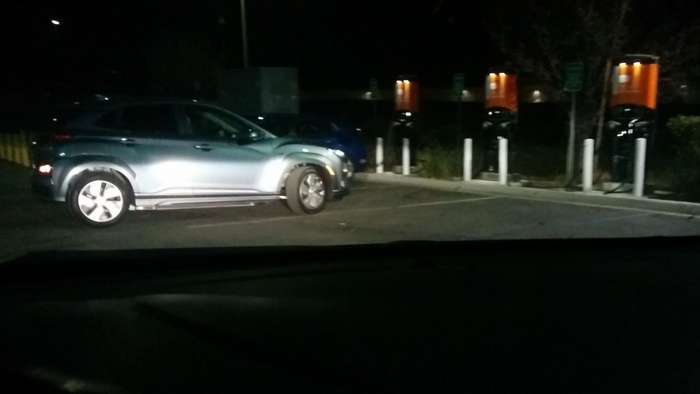
The reason for the backup at this site was because one of the three 50 kW chargers was out of commission. From what I can surmise, the Ioniq owner had been waiting for 20 to 30 minutes for a charger to open up. Luckily, the i3 driver was ready to leave, so the Ioniq owner took that spot. Plus, Josh was back and ready to unplug his Kona and leave. In the end, I waited less than 5 minutes to hook up.
I initially planned to only charge to about 50% battery, but because I don't have charging at home, I decided to charge up a little longer. I need about 25% battery to comfortably make my drive into the office in the morning, so letting it charge up to 65% to 70% was better than topping up at an EVgo when I got back to Ventura. Plus, this ChargePoint site is technically not completely open, so it is still free to charge.
The last time I was there, I was only reviewing the opening of the site, so this time, I decided to go for a walk and check out the area. Tesla recently expanded their nearby Supercharger site, but there are plenty more opportunities for charging sites off this freeway exit.
By the time I got back, the Ioniq driver was getting ready to leave. He was heading north, so he was going to have a decent tailwind for the 116 miles he had to drive to get to Coalinga. Still, the Hyundai Ioniq Electric only has 124 miles of range when full, and it won't DC fast charge past 93% battery. The Level 2 AC chargers at this site still weren't up, so he wasn't able to top off the battery. This was going to be a tough run.
I charged for 56 minutes 34 seconds and ended the charge session at 65%. The charger had delivered 38.75 kWh (no cost).
Trip Summary
The rest of the trip was uneventful for me, and I was able to make it back to Ventura at 12:38 am, after 484.1 miles and 10 hours 8 minutes. My average trip speed was only 47.8 mph, much slower than the nearly 51 mph average for my trip north. And that's despite using less energy and having better efficiency. This southbound trip only required 136.3 kWh at 3.55 mi/kWh.
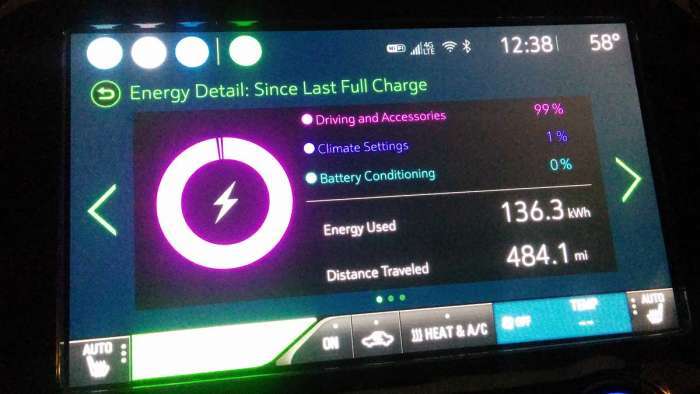
My total charging cost for this southbound trip was $28.86 (assuming $9 for a full charge at my property in Northern California), which brings my average cost per mile to $0.06. That’s almost identical to my cost per mile for the northbound trip, and it further illustrates that these ChargePoint and EVgo chargers are costing about twice as much as the Electrify America units.
I think this trip is a great opportunity to highlight a few key concepts for electric vehicle ownership and traveling.
Driving Speed Matters the Most
First, I want to address the misconception that driving efficiently results in the fastest trips. That is not true. Faster trip speeds are achieved by faster driving (despite worse efficiency). I was able to complete the trip north (average driving speed of 65 mph) 30 minutes faster than the trip south (average driving speed 62 mph). Yes, I had some slowdowns, had to use two slower 50 kW chargers on the southbound trip versus only one slower 50 kW charger on the northbound trip, and charged longer to give myself some extra capacity, but overall, the southbound trip should be much faster due to a net 1,000' elevation decrease.
Bjorn Nyland released a very timely video on this topic; he was testing the Hyundai Kona Electric's average trip speeds for 1,000 km (~621 mi). In the video, he is able to keep his trip times shorter by maintaining higher driving speeds that ranged from 125 to 135 kmh (77 to 83 mph). He also noted the importance of having access to the fastest chargers along the route
.
I did ask Bjorn if he was going to test the Ampera-E (the European version of the Bolt EV), but he didn't seem to have any interest in doing that. It will be hard to find roads near me where I can test the Bolt EV while maintaining similar driving speeds to his tests, but I will try to do so in the near future. Based on my estimates, the Bolt EV should be able to maintain an average trip speed of around 55 mph over 621 miles, so keep an eye out for that story.
Electrify America has the Cheapest Public Fast Charging
Another misconception is that Electrify America is the most expensive public charging option. That is also not true. On this 1,000-mile road trip, I used Electrify America chargers three times and I had two paid sessions between ChargePoint and EVgo. The Electrify America sessions were half the price per kWh as the ChargePoint and EVgo sessions.
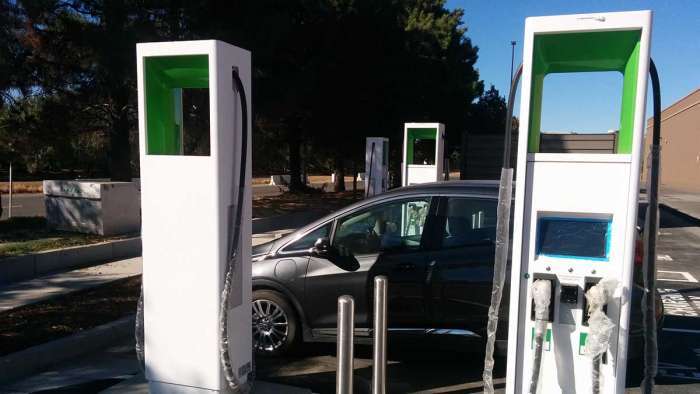
It is true that certain cars such as the Hyundai Kona Electric and Kia Niro EV are in a higher price tier on Electrify America, but they charge at the same rate as the Bolt EV on most ChargePoint and EVgo chargers. That means that a typical charging session will cost Kona and Niro owners around the same amount regardless of which network they are using. The only difference is, the Electrify America sessions will take about 15 to 20 minutes less time.
Charging Site Distribution is Important
The third concept is that charger speed and location really do matter. Unfortunately, at the time of this trip, Electrify America still has not activated any of their faster charging sites between Fresno and Los Angeles, leaving a 200-mile gap that can only be bridged using slower, 50 kW chargers. Each faster than 50 kW charging stop saves Bolt EV owners about 10 minutes, so when this route is completely populated by faster than 50 kW chargers, I will be able to shave at least 10 minutes off my northbound trip and 20 minutes off my southbound trip.
Also, arriving at the Patterson Electrify America charger (the fastest charger I would use on this southbound trip) with 15% battery meant that I couldn’t maximize my fastest charging opportunity. I would prefer to arrive with 5% to 10% battery, so having my first charging stop another 10 to 20 miles out would be better. There are still plenty of opportunities for new charging sites along these routes, ranging from gas stations, to restaurants, to shopping plazas.
I hope this trip review was enjoyable and informative. Let me know if you have any questions or would like to see more of this type of coverage.
See you next time as I predict the upcoming 2020 Bolt EV’s DC charging rates!
About The Author
Eric Way focuses on reporting expert opinion on GM brand electric vehicles at Torque News. Eric is also an instructional designer and technical writer with more than 15 years of writing experience. He also hosts the News Coulomb video blog, which focuses on electric vehicles, charging infrastructure, and renewable energy. Eric is an active member of the EV Advocates of Ventura County, a volunteer organization focused on increasing the widespread adoption of electric vehicles. You can follow Eric on News Coulomb Youtube, on Facebook at @NewsCoulomb as well as on Twitter at @eway1978.

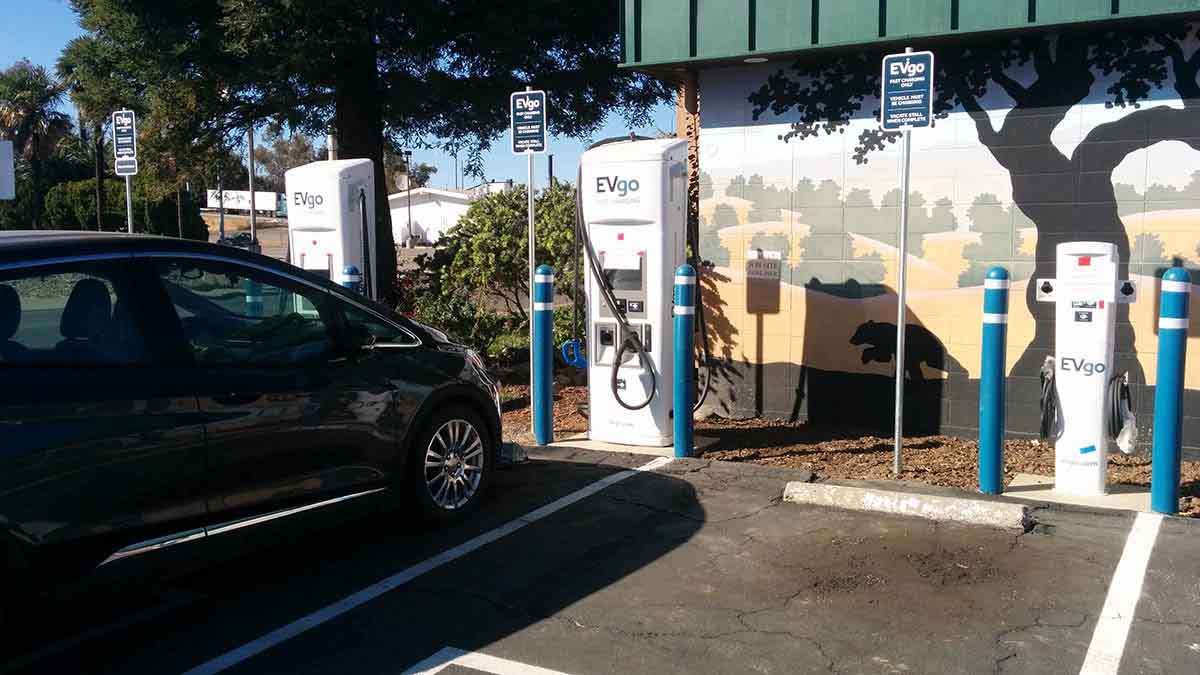




Comments
I drove 2300 miles in a Leaf
Permalink
I drove 2300 miles in a Leaf with a 25% the battery capacity of your Bolt, but I didn't have to write a blog post about it.